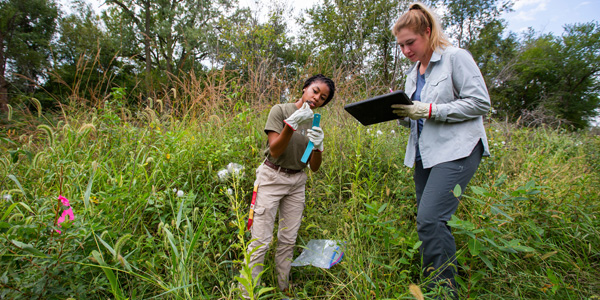
Tracking Iowa’s Wild Species
Trevor Hachmeister carefully holds a white-footed mouse live-trapped in the woods at Big Creek State Park. He weighs and measures the mouse before marking its belly with permanent ink – in case it’s recaptured – and releases it.
Monitoring partner Simone Lord notes the mouse’s measurements on a paper spreadsheet and refreshes the trap with a peanut butter bait wrapped in wax paper. Then they head toward the next orange plastic flag signaling the next trap.
Today, the field technicians are looking for small mammals in central Iowa. Next week, they might be identifying dragonflies in a wetland prairie complex or crayfish along a stream. Sometimes, they search for tracks and signs (like scat) to identify species. Other times, they review data from trail cameras set up to “catch” animals, like weasels, which are tough to document. They regularly spend evenings recording bat echo locations.
They are collecting data for Iowa’s Multiple Species Inventory and Monitoring Program, known as the MSIM. Since 2006, the program has been scouting mostly public land to track the status of more than 1,000 species in the Iowa Wildlife Action Plan. The plan includes birds and insects, reptiles, amphibians, fish and even snails. The Iowa Department of Natural Resources (DNR) coordinates the program in partnership with Iowa State University.
Hachmeister (’19 animal ecology) from Coon Rapids, Iowa, started monitoring for the program in May. “I like the variety,” he says. “Every day we’re doing something different. In high school, I decided I wanted a job that would get me outside. It’s not glamorous, but I enjoy the work, and I think it will look good on my resume.”
Lord, a senior in animal ecology, comes from northern Illinois. She’s earning internship hours — her undergraduate degree program requires 400 hours of relevant work experience. She says this experience will help her decide what she wants to do after college.
“It’s amazing how much we overlook. There’s a lot of life in Iowa we tend to look past, especially small things,” says Lord. “For example, there are a lot of different species of dragonflies in Iowa.”
Over time, MSIM teams have found six species of odonates (dragonflies and damselflies) never before recorded in Iowa. Tianna Kinzie (’19 animal ecology), from Anita, Iowa, started working for the monitoring program following graduation. She says she hopes to work in the field of conservation biology.
“I really appreciate that the broader goal of this effort is to provide information to help ‘keep common species common’,” she says.
Stephen Dinsmore (’90 fisheries and wildlife biology), professor and interim chair for the departments of entomology and natural resource ecology and management, administers the program for Iowa State. His role is, in part, to ensure that protocols for site selection, monitoring and database management are scientifically sound.
“Our partners at DNR use the information our students collect to inform management decisions about what actions to take – such as whether to burn in November or April, or plant grass or forbs – to keep the habitats Iowa’s wildlife need as healthy as possible,” says Dinsmore. “So we need to make sure that we’re providing good data.”
Few states have had such a comprehensive, long-term effort to monitor animals and plants. Every year, Dinsmore helps review a large pool of candidates from the Midwest and beyond who are vying for the chance to work long hours outdoors for the program. Those who get the opportunity often go on to become professors, researchers or wildlife professionals for agencies and nonprofits.
One of his graduate students, Rachel Vanausdall (‘18 MS wildlife ecology), has become the MSIM’s main program biologist. She does the majority of data analysis, conducts training and field visits, helps write papers and supervises field technicians. Today, she leads the team that includes Hachmeister, Lord and other recent Iowa State graduates. Johanna Ford (‘18 MS wildlife ecology), from the Chicago area, was hired for her expertise identifying birds and butterflies. She’s not sure what she wants to do next.
“For now,” she says, “I’m glad to be part of important conservation work that can help us understand what we need to do to protect Iowa’s wild species for the future.”
The work continues, with support from the U.S. Fish and Wildlife Service, the Iowa Department of Natural Resources, Iowa State University and the U.S. Army Corps of Engineers.
A Wild Dinsmore Legacy
A passion to nurture the next generation’s interest in the health of Iowa’s wild species is a family legacy
for Stephen Dinsmore (’90 fisheries and wildlife biology).
His father is Jim Dinsmore, a popular emeritus wildlife ecology professor at Iowa State. Jim also is well-known as author of a notable book on Iowa’s natural history, “A Country So Full of Game: The Story of Wildlife in Iowa.”
As a kid, Stephen often spent after-school and holiday hours hanging out in his dad’s office and tagged along on his field trips. Years later, he works in an office in the same building and revisits some of the same places with his students.
Their work emails help tell the tale.
Jim has long been known as oldcoot@iastate.edu. Stephen can be reached at cootjr@iastate.edu.



